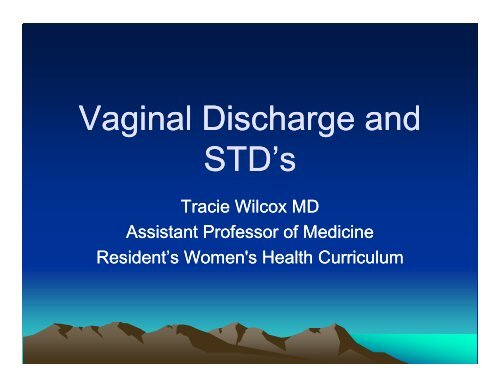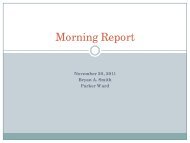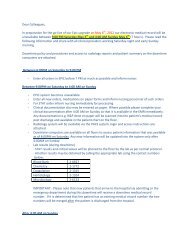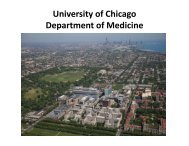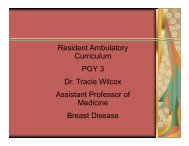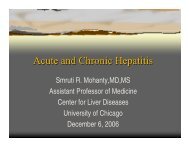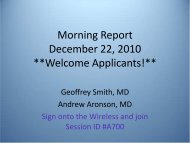Vaginal Discharge And STD
Vaginal Discharge And STD
Vaginal Discharge And STD
You also want an ePaper? Increase the reach of your titles
YUMPU automatically turns print PDFs into web optimized ePapers that Google loves.
<strong>Vaginal</strong> <strong>Discharge</strong> <strong>Discharge</strong> and<br />
<strong>STD</strong>’s <strong>STD</strong> <strong>STD</strong>’s s<br />
Tracie Wilcox MD<br />
Assistant Professor of Medicine<br />
Resident’s Women's Health Curriculum
• Etiology: gy<br />
– Infectious causes<br />
<strong>Vaginal</strong> <strong>Discharge</strong><br />
• BV<br />
• Candidiasis<br />
• Trichimonas<br />
• Cervicitis - GC/Chly, trich, mycoplasma genitalium,<br />
ureaplasma urealyticum<br />
– Chemical irritants<br />
– Hormone deficiency – atrophic vaginitis<br />
– Malignancy<br />
– Physiologic - normal discharge<br />
– Nonvaginal – ex: abscess, abscess urethral discharge
Epidemiology<br />
• Lifetime risk for yeast vaginitis 75%<br />
– Antifungal medication among top 10 of all<br />
nonprescription meds<br />
• Estimated $275 million annually<br />
• Self-diagnosis based upon symptoms<br />
Self-diagnosis based upon symptoms<br />
frequently incorrect
Vulvovaginal Candidiasis<br />
• Accounts for 17-30% of cases of vaginitis g<br />
– >90% of cases due to C. albicans<br />
• Signs and symptoms:<br />
– Thick Thick, curdy, curdy white, white nonodorous discharge<br />
– Burning, itching, irritation, dyspareunia<br />
• Risk factors<br />
– antibiotic use<br />
• Rate of symptomatic infection 20-25%<br />
– Diabetes<br />
–HIV<br />
– Sexual activity<br />
– Pregnancy
• Dx:<br />
Vulvovaginal Candidiasis<br />
– Physical exam findings<br />
• Erythema and edema of vulva and vagina<br />
• Clumpy, white adherent discharge<br />
– Wet mount<br />
• pH normal (4-4 (4-4.5) 5)<br />
• Yeast/hyphae seen in 60-70% on KOH stain<br />
• No increase in PMN’s on saline stain<br />
– Culture<br />
• Recurrent Candida vaginitis or for vaginitis unresponsive to<br />
antimycotic y therapy py
KOH For Budding Budding Yeast Yeast & Hyphae<br />
Medscape p today. y<br />
Candidiasis. 1999
Treatment<br />
• Uncomplicated infection<br />
• Sporadic, infrequent episodes<br />
• Not pregnant<br />
– Oral and intravaginal treatments equally effective w/<br />
clinical cure rate > 80%<br />
– OOral l fluconazole fl l 150 mg po x one ddose<br />
– Intravaginal clotrimazole, miconazole,<br />
terconazole for 11,3,7, 3 7 or 14 days
Treatment<br />
• Complicated infections<br />
– Poorly controlled diabetes, pregnancy,<br />
recurrent infection, immunocompromised,<br />
infection with non-albicans Candida, or severe<br />
disease choose prolonged therapy<br />
• 2 doses of oral fluconazole 72 hours apart<br />
• 7-10 days of topical therapy<br />
– Pregnant women<br />
– > 4 episiodes/yr<br />
• Maintenance regimen of fluconazole 150 mg po<br />
once weekly x 6 months
Bacterial Vaginosis<br />
• Replacement of Lactobacillus species by<br />
vareity of anaerobic bacteria<br />
– Gardnerella vaginalis<br />
– Mycoplasma hominis<br />
• MMost t frequent f t cause of f vaginal i l discharge di h<br />
– 22-50% of all cases<br />
• > 50% of affected women are<br />
asymptomatic
• Risk factors<br />
BV<br />
– Multiple sex partners<br />
– Douching<br />
– IUD use<br />
– AA race<br />
– Exposure to STI’s
• Diagnosis g<br />
– Hx and PE:<br />
BV<br />
• Thin, white-gray vaginal discharge<br />
• Malodor noticed after intercourse or menses<br />
• Itching, burning, irritation of vagina<br />
– Wet mount:<br />
• Clue cells on saline prep<br />
• Fishy odor on KOH prep<br />
• <strong>Vaginal</strong> pH >4.5<br />
– Inclusion of any 3 of either 1,4,5,6 gives sensitivity of<br />
92% and specificity of 77% = Amsel’s criteria
Clue Cells
• Treatment<br />
BV<br />
– Metronidazole 500 mg po BID x 7 days<br />
• Preferred regimen in pregnant women<br />
– Metronidazole gel 0.75% - 1 applicator full<br />
(5g) intravaginally for 5 days<br />
– Clindamycin cream 2% - 1 applicator full (5g)<br />
IV x 7 days y<br />
• Preferred regimen if metronidazole allergy
• Recurrent disease<br />
BV<br />
– 30 % of women will develop recurrence<br />
– Women with more than 3 episodes in one<br />
year<br />
• Suppressive therapy with metro gel 2x/wk x 6<br />
Suppressive therapy with metro gel 2x/wk x 6<br />
months
Trichomonas Trichomonas <strong>Vaginal</strong>is<br />
• Infection with protozoan trichomonas<br />
vaginalis<br />
• Accounts for anywhere b/w 44-35% 35% of<br />
cases of vaginitis<br />
• SSexually ll ttransmitted itt d
Trichomonas Trichomonas <strong>Vaginal</strong>is<br />
• Clinical features:<br />
– Purulent, malodorous, thin discharge<br />
– <strong>Vaginal</strong> burning, burning pruritis pruritis, dysuria dysuria, dyspareunia<br />
• PE fi findings: di<br />
– Vulvar and vaginal erythema<br />
– Green discharge (10-30%)<br />
– Punctate hemorrhages on cervix ( 2%)
• Diagnosis<br />
Trichomonas Trichomonas <strong>Vaginal</strong>is<br />
– Motile trichomonads on wet mount (50-70%)<br />
– Ph > 44.5 5<br />
– Increased WBC’s on wet mount ( >5 per high<br />
power field)<br />
– culture
Trich on on Saline Wet Mount<br />
Buxton, R. Examination of vaginal secretions.2/6/07: Microbelibrary.org
• Treatment<br />
– Metronidazole<br />
Trichomonas<br />
• 2 grams po x one<br />
• 500 mg po BID x 7 days<br />
• 85-90% cure rate<br />
• Desensitization if allergic<br />
• No alcohol for 24 hrs after treatment<br />
• Do not use intravaginal therapy<br />
• Treat partner p<br />
• No intercourse for one week after treatment<br />
completed
At Home Home Testing<br />
Testing<br />
• Vagisil screening kit available OTC for<br />
women with vaginal d/c, itching,<br />
unpleasant odor<br />
• Tests pH of vaginal discharge<br />
• If 4.5 4 5 - recommend dttreatment t tf for yeastt<br />
• If 5 or greater - recommend following up<br />
with doctor for further evaluation
Atrophic Vaginitis<br />
• Dryness and inflammation of vaginal mucosa<br />
with thinning of epithelium due to estrogen<br />
deficiency<br />
• Prevalence in postmenopausal women 47%<br />
• Can also be seen in premenopausal p p women<br />
– Post partum<br />
– Lactating<br />
– Anti-estrogenic medications
Atrophic Vaginitis<br />
• Clinical manifestations<br />
– <strong>Vaginal</strong> dryness<br />
– Burning<br />
– Dyspareunia<br />
– <strong>Vaginal</strong> itching<br />
– <strong>Vaginal</strong> discharge<br />
– V<strong>Vaginal</strong> i l spotting tti or bleeding bl di<br />
– Urinary tract symptoms
• Clinical<br />
– History<br />
– Pelvic exam<br />
Atrophic Vaginitis<br />
• Loss of pelvic hair<br />
• Diminished elasticity and turgor of vulvar skin<br />
• Urethral prolapse<br />
• Pale, dry,smooth y and shiny y vaginal g epithelium p<br />
• Friability of epithelium
Atrophic Vaginitis<br />
• Treatment<br />
– Local moisturizers and lubricants<br />
• Ex: replens<br />
– estrogen t therapy th<br />
• Intravaginal therapy<br />
– estrogen ring<br />
– estrogen t tablets t bl t<br />
– Estrogen cream<br />
• Dose: 1/8th of applicator q day x one week then 2-3 x per<br />
week<br />
• Progestin not necessary in women on low dose therapy<br />
• No estrogen therapy in women with hx of breast cancer
Chlamydia<br />
• Chlamydia trachomatis most commonly<br />
reported <strong>STD</strong> in US<br />
– Higher rates in adolescents and AA women
Chlamydia<br />
• Clinical presentations<br />
– Cervicitis<br />
• > 50% may be asymptomatic<br />
• <strong>Vaginal</strong> discharge, abdominal pain<br />
– Urethritis<br />
–PID<br />
• Seen in 30% of untreated women<br />
– Pregnancy risks<br />
• PROM, , low birth rate, , conjunctivitis, j , pneumonia p
• Diagnosis<br />
Chlamydia<br />
– Nucleic acid amplification<br />
• Gold standard<br />
– Endocervical, urethral, or urine sample<br />
– 94-98% sensitive for endocervical sample and 80-99%<br />
sensitive iti ffor urine i sample l<br />
– Expensive but most sensitive test available<br />
– can also be used to detect Neisseria gonorrhoeae in the<br />
same specimen
• Treatment<br />
Chlamydia<br />
– Azithromycin 1 gram po x one<br />
– Doxycycline 100 mg po BID x 7 days<br />
– Both with 97-98% cure rates<br />
• Treat partners<br />
• Test for other <strong>STD</strong>’s<br />
• No need to test for cure but should repeat<br />
screening to rule out recurrent infection<br />
within one year
N. Gonorrhea<br />
Gonorrhea<br />
• Clinical presentation<br />
– Asymptomatic<br />
– Cervical infection<br />
• Pruritis and mucopurulent discharge<br />
– Urethritis<br />
–PID<br />
• Seen in 10 10-40% 40% of women with gonorrhea<br />
– Oropharyngeal infection
N. Gonorrhea<br />
Gonorrhea<br />
• Diagnosis g<br />
– Nucleic acid amplification test – best test available<br />
• Endocervical swab<br />
• Liquid based pap smear<br />
• Urine<br />
– Lower sensitivity due to substances in urine that can interfere<br />
with test (85% vs 96%)<br />
– Not approved by FDA<br />
• Self-collected <strong>Vaginal</strong> swab – kits available via mail on line<br />
– Culture from endocervical sample<br />
• Only 65-80% sensitive in asymptomatic women<br />
– DNA probe from endocervical swab
N. Gonorrhea<br />
Gonorrhea<br />
• Treatment for cervicitis/urethritis<br />
– Increased resistance to penicillin, tetracycline<br />
and ciprofloxacin<br />
– Recommended: ceftriaxone 125 mg IM x1<br />
– oral alternative: cefixime 400 mg po x 1<br />
– Treat for concomitant chlamydia infection<br />
• Azithromycin 1 gram po x 1<br />
– Increasing to 2 grams po x 1 will trx both gon/chl but<br />
limited by side effects<br />
• Doxycycline 100 mg po BID x 7 days
• Follow up<br />
N. Gonorrhea<br />
Gonorrhea<br />
– No need to test for cure<br />
– Check for other STI’s STI s
Pelvic Pelvic Inflammatory Disease<br />
• Acute infection of the upper genital tract<br />
structures in women, involving any or all of<br />
the uterus uterus, oviducts, oviducts and ovaries<br />
• Microbiology<br />
– NN. gonorrhea h – 1/3 of f cases<br />
– Chlamydia – 1/3 of cases<br />
– Mi Mixed d iinfection f i – strep, e.coli, li kl klebsiella, b i ll<br />
anaerobes
• Risk factors<br />
PID<br />
– Number of sexual partners<br />
– Age<br />
• 15-25 years old w/ highest frequency<br />
– Symptomatic male partner<br />
– Previous PID<br />
– African American women
Pelvic Pelvic Inflammatory Disease<br />
• Clinical symptoms y p<br />
– Abdominal pain<br />
– <strong>Vaginal</strong> bleeding<br />
– <strong>Vaginal</strong> discharge<br />
– Urethritis<br />
• PE<br />
– Abdominal pain<br />
– Fever<br />
– Bimanual exam with CMT or adnexal tenderness<br />
– Cervical discharge
• Diagnosis<br />
– Pregnancy test<br />
– U/A<br />
PID<br />
– Cervical sample for GC/ Chlamydia<br />
– Pelvic ultrasound
• Treatment<br />
– Outpatient<br />
PID<br />
• Ceftriaxone 250 mg IM x 1 + doxycycline 100 mg po BID x<br />
14 days<br />
• Add metronidazole if concern for pelvic abscess, suspected<br />
infection with Trichomonas, or recent instrumentation<br />
– Inpatient<br />
• Cefoxitin 2 G IV q 6 + doxycycline 100 mg po/IV Q12<br />
• Amp/Sulbactam 3 G IV q 6 + doxycycline po/IV<br />
• Oral administration of doxyxycline preferred due to pain<br />
associated with drug administration when infused<br />
– bioavailability of oral AND IV preparation equivalent
• Complications<br />
PID<br />
– Perihepatitis: Fitz-Hugh Curtis Syndrome<br />
• RUQ pain with pleuritic component<br />
• Abnormal LFT’s<br />
– Tubo-ovarian Tubo ovarian abscess<br />
– Chronic pelvic pain –seen in 1/3 of patients<br />
– Infertility<br />
– Ectopic pregnancy
Anogenital HPV<br />
• Single or multiple smooth or verrucous<br />
papules on the penis, vulva, cervix,<br />
vagina vagina, perineum perineum, or anal region<br />
• Most common viral <strong>STD</strong> in US
Chemical:<br />
Treatment Options<br />
– Aldara (Imiquimod)<br />
( q )<br />
– Podofilox 0.5%<br />
– TCA<br />
– Podophyllin resin<br />
– Interferon alpha<br />
– 5 FU epinephrine gel<br />
Surgical Options:<br />
Cryotherapy<br />
Laser<br />
Scalpel Excision
• Home treatment<br />
Imiquimod Imiquimod (Aldara)<br />
• 5% cream self administered<br />
• Apply 3x/week for up to 16 weeks<br />
• Immune modulator<br />
• Leave on for 6 hours then remove with soap and<br />
water (generally apply QHS)<br />
• Avoid in mucosal areas areas, do not use with<br />
diaphragm<br />
• Clearance rate: 50-100% 50 100%
• Self-administered<br />
Self administered<br />
• Anti-mitotic agent<br />
Podofilox<br />
• AApplied li d 2 2x/d /d x 3 ddays th then 4 dday rest t<br />
period<br />
– May repeat up to 4 times<br />
• Cure rate - 45-90%
• TCA<br />
Trichloroacetic Trichloroacetic acid<br />
– In office procedure<br />
– 70% success rate<br />
– Apply 1x per week for 4 weeks<br />
– Caustic agent g which pphysically y y destroys y the<br />
wart tissue<br />
– Can get painful chemical burns, scarring and<br />
ddepigmentation i t ti of f surrounding di areas<br />
– Can be used in pregnancy
Genital HSV HSV Infection<br />
Infection<br />
• Most common cause of genital ulcers<br />
• Genital disease may be from HSV 1 or<br />
HSV 2<br />
• Rates increased in females, AA, age 14-<br />
40’ 40’s, and d in i patients ti t without ith t previous i HSV<br />
1 antibodies<br />
• Recurrent disease more common with<br />
HSV 2 infection
Clinical Clinical Manifestations<br />
• Primary infection<br />
– Genital pain and itching<br />
– Dysuria<br />
– Painful LAD<br />
– Systemic y symptoms y p –HA, , fever, , malaise<br />
– Genital lesions<br />
• Secondary y infection<br />
– Less severe with less lesions and usually<br />
unilateral w/o systemic symptoms
Physical Exam<br />
• Vesicles Vesicles, followed 2-3 2 3 days later by<br />
pustules, then ulcers, then crusted lesions<br />
• Lesions isolated or coalesced<br />
• Tender LAD
Herpes
Diagnosis<br />
• Viral culture of lesion = standard dx method<br />
– Unroof alcohol wiped vesicle with needle and remove<br />
fluid with cotton swab and place in viral culture<br />
medium<br />
• Serology<br />
– a ffourfold f ld or greater t rise i in i antibody tib d titers tit is i observed b d<br />
between acute and convalescent sera in patients with<br />
primary p y infection<br />
– HSV subtypes helpful in predicting risk of recurrence
Treatment<br />
• Primary y infection<br />
– Acyclovir 200 mg po 5x/d x 7-10 d<br />
– Valacyclovir 1 g po BID x 7-10 d<br />
• Recurrent episodes<br />
– Acyclovir 800 mg po 3x/d x 2 days<br />
– Valacyclovir 500 mg 2x/d x 3d<br />
• Suppressive therapy - >5 / yr<br />
– Valacyclovir 500 mg po QD<br />
– Acyclovir 400 mg po BID<br />
– Famciclovir 250 mg po BID
Prevention<br />
• Suppressive therapy<br />
• Condom use<br />
• AAvoid id sexual l encounter t dduring i bbreakout k t<br />
The Relationship between Condom Use and Herpes Simplex Virus Acquisition1.Anna Wald , MD, MPH;<br />
Langenberg , MD; Elizabeth Krantz , MS et al al. Annals of Internal Medicine. Medicine November November 15 15, 2005vol 2005vol. 143 no no. 10 707 707-713.<br />
713<br />
<strong>And</strong>ria G.M.
Syphilis<br />
• Sexually y transmitted disease caused by y the<br />
bacterium Treponema pallidum<br />
• Most cases occur in persons 20 - 39 years of age<br />
• Increasing rates of infection<br />
• Clinical manifestations:<br />
– Primary syphilis<br />
– Secondary syphilis<br />
– Latent and Late (tertiary) syphilis
Primary Primary Syphilis<br />
Syphilis<br />
• single g sore (chancre) ( ) or multiple p sores occurring g<br />
10 -90 days after infection is acquired ( avg 21<br />
days)<br />
• chancre h is i usually ll fi firm, round, d small, ll and d<br />
painless<br />
• The chancre lasts 3 to 6 weeks then heals<br />
without treatment
Chancre
Secondary Syphilis<br />
• Hematogenous dissemination occurring 2-8 2 8<br />
weeks after chancre<br />
• Skin rash<br />
– Rough, red, red-brown, classically on palms and<br />
soles<br />
– Non itchy<br />
• Mucocutaneous lesions<br />
• LAD<br />
• HA, muscle aches, fatigue, sore throat<br />
• Genital condyloma latum
Latent Latent Syphilis<br />
• Asymptomatic stage after symptoms of<br />
secondary syphilis subside<br />
• Early latent defined as < 1 year after<br />
primary infection
Tertiary Tertiary Syphilis<br />
Syphilis<br />
• Cardiovascular - aortitis involving<br />
ascending aorta, aortic aneurysms, aortic<br />
regurgitation<br />
• Neurologic - most common manifestation<br />
in US<br />
• Osteomyelitis<br />
• hepatitis
• Asymptomatic<br />
• Symptomatic<br />
Neurosyphilis<br />
– Meningovascular syphilis - 4-7 4 7 yrs after infection<br />
• Stroke, cranial nerve abnormalities<br />
– Paraenchymatous syphilis<br />
• Decades after infection<br />
• Progressive dementia, personality changes<br />
• Sensory ataxia, loss of proprioception, lighting pains,<br />
y , p p p , g g p ,<br />
autonomic dysfunction, optic atrophy, disturbed sensation
Diagnosis<br />
• Dark field microscopy<br />
• Antibody levels<br />
– RPR or VDRL - nontreponemal tests<br />
• Titers useful to monitor response to therapy<br />
– FTA-ABS or TPHA - treponemal p tests -<br />
confirmatory<br />
• LP - mononuclear pleocytosis, increased<br />
protein value; VDRL 30-70% sensitive in<br />
spinal fluid
Treatment<br />
• Primary, y, secondary, y, early y latent infection<br />
– Benzathine Penicillin G 2.4 million units IM x one<br />
• Alternatives: doxy 100 mg BID x 14 days, tetracycline 500<br />
mg po QID x 14 days<br />
• Late latent, tertiary<br />
– Aqueous Benzathine penicillin G 2.4 million units IM q<br />
week x 3 weeks<br />
• Neurosyphilis - PCN G 3-4 million units IV q day<br />
x10 x 10 - 14 days<br />
– desensitization if allergic<br />
Diagnosis and Management of SyphilisDAVID L. BROWN, MAJ, MC, USA, and JENNIFER E. FRANK,<br />
CPT, MC, USADeWitt Army Community Hospital, Fort Belvoir, VirginiaAm Fam Physician.ハ2003ハJulハ<br />
15;68(2):283-29
Follow Up<br />
• After adequate treatment treatment, non treponemal<br />
tests titers will decline and will become<br />
nonreactive though may have persistent<br />
low level positive titer<br />
– Consider re re-treatment treatment if levels don’t don t decrease<br />
4 fold in 12-24 months<br />
• Treponemal tests will remain reactive for<br />
• Treponemal tests will remain reactive for<br />
life
Screening Guidelines<br />
• Screen for Chlamydia in the following groups<br />
(CDC and USPTF):<br />
– All sexually active women age 25 years or younger<br />
(including pregnant women)<br />
– Sexually active women older than 25 years with risk<br />
factors<br />
• new partner in prior 60 days, more than one sex partner,<br />
inconsistent condom use, unmarried, or history of <strong>STD</strong><br />
– Insufficient evidence to recommend routine screening<br />
in sexually active men
Screening Continued<br />
• Screening for N. Gonorrhea<br />
– Sexually active women younger than 25 years<br />
– Inconsistent condom use<br />
– A history of multiple partners or a partner with multiple<br />
contacts<br />
– SSexual l contact t t with ith a partner t with ith culture-proven lt <strong>STD</strong><br />
– A history of repeated episodes of <strong>STD</strong><br />
– Sex work or drug use<br />
– Pregnancy
Screening Continued<br />
• HIV screening:<br />
– recommended for all patients b/w 13-64 in<br />
health care settings (CDC)<br />
– USPTF gives A recommendation for<br />
screening patients with one risk factor or in<br />
area where prevalence >/1%<br />
– USPTF gives g C recommendation for all other<br />
patients


